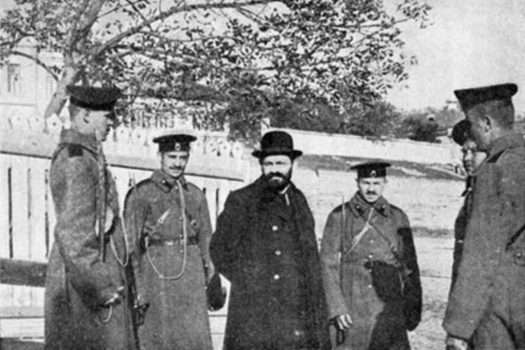
100 Years: The Rebbe Rashab and the Beilis Trial
The trial of Mendel Beilis—a Jewish factory manager in Kiev, Ukraine, accused of murdering a Christian child to use his blood to bake matzah for Passover—began 100 years ago this month. Reported on closely by the international press, the world watched the unfolding—with reactions ranging from liberal astonishment to Jewish anguish to anti-Semitic satisfaction—of what was to be the last major blood-libel case of the 20th century.
Now, a century later, Chabad-Lubavitch historian Eli Rubin has unearthed new information that remained unknown to modern-day researchers of the trial. Some of his discoveries were recently published on Chabad.org in an article titled The Tsar’s Scapegoats: Beilis, the Chassidim and the Jews.
The Beilis Case, a site hosted by Chabad.org dedicated to the Beilis trial, also features a photo essay of the leading players in the drama: The Beilis Case in 20 Pictures; and will include a gallery of rare newspaper clippings and court transcripts, some of which have been buried away in archives since their initial publication, including a full-transcript of Rabbi Yaakov Mazeh’s testimony for the defense; and a series of videos featuring contemporary experts—and the grandson of Mendel Beilis—on the trial.
Framing the Chassidim
The Mendel Beilis saga began in March of 1911, two years before the trial, when the mutilated body of 13-year-old Andrei Yushchinsky was discovered in a cave not far from a Jewish-owned brick factory on the outskirts of Kiev, where the 39-year-old Beilis worked. Police investigators concluded that the young boy had been murdered by career criminal Vera Cheberiak and her gang, which became suspicious that Yushchinsky knew too much about their criminal activity.
Instead of prosecuting Cheberiak, however, the imperial Russian government—reaching up to the highest echelons of power, including the Czar himself—decided to pin the murder on Beilis and frame the case as one of Jewish ritual murder.
During the month-long trial held at the Kiev Superior Court, the prosecution worked to prove that Cheberiak and her companions were innocent of the murder, and to establish that Jews, specifically Chassidic Jews, frequently engaged in the ritual murder of Christian children. What was overlooked until Rubin’s recent discoveries has been the extent to which the Chabad-Lubavitch branch of Chassidism was targeted in particular.
Rubin found evidence of a meeting held prior to Beilis’s arrest between Jewish community leaders and the editorial staff of a major monarchist news magazine. These leaders professed Beilis’s innocence; they also refused to accept the government’s request that the Jewish community assert its general innocence by admitting that Chassidim were a fringe sect that committed heinous crimes.
He also discovered a transcript of Rabbi Yaakov Mazeh’s expert testimony for the defense, which focused heavily on the history of Chassidism and the teachings of Chabad, demonstrating just how central Chabad’s role in the trial proved to be.
A Definitive Meeting
Previously, many experts concluded that the Jewish community was slow to come to the defense of Beilis. According to Edmund Levin, whose book Child of Christian Blood: Murder and Conspiracy in Tsarist Russia: The Beilis Blood Libel will soon be released by Schocken, Rubin’s research is significant because it contradicts this narrative, showing that the Jewish leadership in Kiev was actively taking steps to counter the anti-Semitic charges even before Beilis’s arrest.
As early as April 1911, a Jewish group headed by Kiev Chief Rabbi Shlomo Ahronson and prominent Jewish attorney Arnold Margolin met with noted monarchist Professor Vasily Chernov and the editorial staff of Kievlianin, an influential mouthpiece of the pro-imperial, anti-Semitic, nationalist intelligentsia.
Ahronson, a representative of the mainstream Jewish community, was asked to disown the Chassidim as a fanatical fringe sect, endorsing the false allegation that they were guilty of ritual murder. He and his group refused to do so, stating, “Among us Jews there are no sects or parties … The Chassidim are not sectarian at all, but a stream within Judaism; a very important stream indeed.”
Following the meeting, the Kievlianin surprised many by taking a strong stance against the sham prosecution of Mendel Beilis.
“The most significant of Eli’s discoveries was this meeting between Ahronson and Margolin, and these national editors,” explains Levin. “As is common in many cases, the Jewish community was afraid of getting involved and was asking itself, ‘Are we going to do more harm than good?’ In the Heint, a Yiddishpaper of the day, there was a discussion of what the community’s response should be, and one report sites Ecclesiastes that there’s a time to be silent, and this is one of them. A few weeks later, they thought the story had passed and they said, ‘See? We did the right thing.’
“But the fact that this meeting was held with the Kievlianin is very significant because the paper became well-known for opposing the government line and calling the Beilis case a travesty.”
Building a Case
This theme of unity in the face of hatred was again embodied in the testimony of Rabbi Yaakov Mazeh of Moscow, who served as an expert witness for the defense. According to Rubin, Mazeh’s testimony was one of the highlights of the trial.
“There were glowing reports in the Jewish press praising his eloquent defense, and he became famous for a feat of oratory that lasted an entire day. But initially,” says Rubin, “I was unable to discover anything substantive about the content of his speech. After searching high and low, I eventually found that a Hebrew-language transcript had been serialized following the trial in the Jewish daily Hatzefira.”
Mazeh’s testimony shows that the main thrust of the case was built against Chabad-Lubavitch Chassidim specifically. Echoing the suggestions made two years earlier to Rabbi Aharonson of Kiev, “the prosecution falsely portrayed them as a barbaric sect, rather than a part of mainstream Judaism.” It was these claims that Mazeh set out to refute.
Rubin supplemented these discoveries with numerous other details, drawing on recently published correspondence to demonstrate that the defense lawyers recognized how central Chassidism was to the case. One letter deals with their request that the fifth Rebbe of Chabad-Lubavitch, Rabbi Shalom DovBer Schneersohn, travel to advise them in person during the run-up to the trial. The suggestion was rejected partly because it was feared that prosecutors might use his participation to associate him with the crime.
Tali Loewenthal, a noted expert in Chabad Chassidisim and a lecturer at University College London, describes the unified response of the Jewish community in the face of an attack on one specific strain of Judaism during the trial as inspiring. “The focus on Lubavitch is quite striking, and it’s impressive how the rest of the Jewish community really rallied together and refused to accept the premise of the prosecution,” he says. “The community stood up and together said no, the Chassidim are not a sectarian group; we will not accept this. It was a unique moment of Jewish unity.”
Robert Weinberg, a professor of history at Swarthmore College and the author of Blood Libel in Late Imperial Russia: The Ritual Murder Trial of Mendel Beilis (forthcoming from Indiana University Press), explains that Rubin’s discovery has added yet another level of knowledge to the trial. “The material that Eli uncovered with regards to the role of Lubavitch enhances our understanding of the case,” he says. “My feeling is that it certainly contributes a deeper understanding of how one particular group responded to the case.”
Still Crucial a Century Later
The jury’s verdict exonerated Beilis, but stated that the prosecution had proven that Yushinsky had been murdered “in the brick factory belonging to the Jewish surgical hospital” and was done in a manner designed to draw “five glasses of blood.”
After the trial, Beilis left with his wife and five children to the Holy Land before eventually moving to New York City. His funeral in 1934 was held at the Eldridge Street Synagogue on Manhattan’s Lower East Side and was attended by some 4,000 people. Beilis is buried at the Mount Carmel cemetery in Queens.
For Jay Beilis, grandson of Mendel Beilis and one of the editors of Blood Libel: The Life and Memory of Mendel Beilis, the trial’s 100-year anniversary represents a time to revisit the hot-button issues surrounding the blood libel.
“The story is still important today because the fact is that it changed the way the course of history for so many Jews,” says Beilis, whose father Dovid was Mendel’s second child. “I remember people coming up to my father when they heard his name and saying that they left Russia as a result of my grandfather’s trial.”
“It’s also significant,” he adds, “because the blood libel has not died and is still very alive in the Muslim world.”
Loewenthal says the Jewish approach to battling such propaganda is by becoming a living example of how a moral human being should act.
“The Rebbe [Rabbi Menachem M. Schneerson, of righteous memory] introduced this concept when he encouraged Jews to spread the Noahide laws,” explains Loewenthal. “The Rebbe said that we cannot live in a goldfish bowl; we must influence the world at large as moral beings. We should be seeking to change the world.”
















1st to respond
Thank you. Glad this info is available to us.
CH Riots
The 1991 Crown Heights riots were a much later 20th Century blood libel.